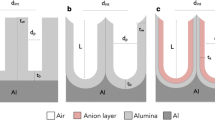Abstract
A cellular automata model to simulate nanostructured alumina creation via anodization is proposed. The model mimics the Field Assisted Dissolution theoretical approach of the anodization process. The key parameters influencing the structures of the layer are identified and an attempt to recreate the two step anodization procedure in simulation conditions is made. The effect of dissolution rate and surface diffusion are considered. Simulation have been run on NVIDIA Tesla cards using the techniques of parallel programming to increase speed of the simulations.
An Erratum for this chapter can be found at http://dx.doi.org/10.1007/978-3-319-11520-7_75
Access this chapter
Tax calculation will be finalised at checkout
Purchases are for personal use only
Preview
Unable to display preview. Download preview PDF.
Similar content being viewed by others
References
Wang, J., Zhao, L., Lyn, V.Y.-S., Lin, Z.: Journal of Material Chemistry 19, 3682–3687 (2009)
Rezazadeh, H., Ebrahimzadeh, M., Yam, M.R.Z.: World Academy of Science. Engineering and Technology 70, 30–32 (2012)
Garcia-Vergara, S.J., et al.: Electrochimica Acta 54, 3662–3670 (2009)
Keller, F., Hunter, M.S., Robinson, D.L.: Journal of the Electrochemical Society 100, 411–419 (1953)
Mutalib Jani, A., Losic, D., Voelcker, N.: Progress. Mater. Sci. 58, 636–704 (2013)
Masuda, H., Fukuda, K.: Science 268, 1466–1468 (1995)
Li, A.P., et al.: Journal of Applied Physics 84, 6023–6026 (1998)
Jessensky, O., Muller, F., Gosele, U.: Journal of the Electrochemical Society 145, 3735–3740 (1998)
Masuda, H., Yada, K., Osaka, A.: Japanese Journal of Applied Physics Part 2 - Letters 37, L1340–L1342 (1998)
Matsuda, H., Satoh, M.: Japanese Journal of Applied Physics Part 2 - Letters 35, L126–L129 (1996)
Hoar, T.P., Mott, N.F.: Journal of Physics and Chemistry of Solids 9, 97–99 (1959)
Garcia-Vergara, S.J., Iglesias-Rubianes, L., Blanco-Pinzon, C.E., Skeldon, P., Thompson, G.E., Campestrini, P.: Proc. R. Soc. A 462, 2345–2358 (2006)
Landau, R.H., Paez, M.J., Bordeianu, C.C.: Computational Physics. NACE International, Houston (2005)
Author information
Authors and Affiliations
Editor information
Editors and Affiliations
Rights and permissions
Copyright information
© 2014 Springer International Publishing Switzerland
About this paper
Cite this paper
Łukasz, B., Janusz, S., Caprio Dung, D. (2014). Modelling Ordered Nanopourous Structures by Anodization via Cellular Automata. In: Wąs, J., Sirakoulis, G.C., Bandini, S. (eds) Cellular Automata. ACRI 2014. Lecture Notes in Computer Science, vol 8751. Springer, Cham. https://doi.org/10.1007/978-3-319-11520-7_19
Download citation
DOI: https://doi.org/10.1007/978-3-319-11520-7_19
Publisher Name: Springer, Cham
Print ISBN: 978-3-319-11519-1
Online ISBN: 978-3-319-11520-7
eBook Packages: Computer ScienceComputer Science (R0)




